Suzuki Grand Vitara: Parking Brake Lever
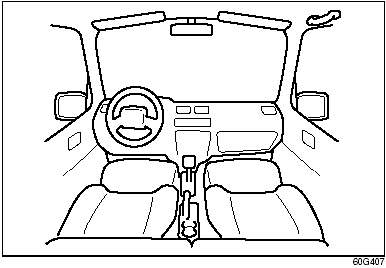
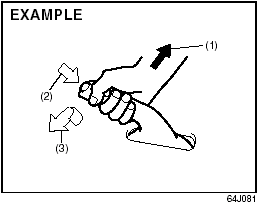
Parking Brake Lever (1) To set (2) To release (3) To release
The parking brake lever is located between the seats. To set the parking brake, hold the brake pedal down and pull the parking brake lever all the way up. To release the parking brake, hold the brake pedal down, pull up slightly on the parking brake lever, push the button on the end of the lever with your thumb and lower the lever to its original position. For automatic transmission vehicles, always set the parking brake before moving the gearshift lever to the “P” (Park) position. If you park on an incline and shift into “P” before you set the parking brake, the weight of the vehicle may make it difficult to shift out of “P” when you are ready to drive the vehicle. When preparing to drive the vehicle, move the gearshift lever out of the “P” position before releasing the parking brake.
 WARNING:
WARNING:
• Never drive your vehicle with the parking brake set: rear brake effectiveness can be reduced from overheating, brake life may be shortened or permanent brake damage may result.
• If the parking brake does not hold the vehicle securely or does not fully release, have your vehicle inspected immediately by an authorized SUZUKI dealer.
 WARNING: Always set the parking brake fully before leaving your vehicle or it may roll, causing injury or damage. When parking, make sure the gearshift lever for manual transmission vehicles is in 1st gear or “R” (Reverse) and the gearshift lever for automatic transmission vehicles is in “P” (Park). Never leave the transfer lever in “N” (Neutral) when you are parked. Remember, even though the transmission is in gear or in Park, you must set the parking brake fully.
WARNING: Always set the parking brake fully before leaving your vehicle or it may roll, causing injury or damage. When parking, make sure the gearshift lever for manual transmission vehicles is in 1st gear or “R” (Reverse) and the gearshift lever for automatic transmission vehicles is in “P” (Park). Never leave the transfer lever in “N” (Neutral) when you are parked. Remember, even though the transmission is in gear or in Park, you must set the parking brake fully.
Pedals
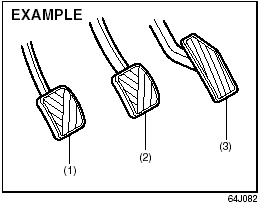
Manual transmission
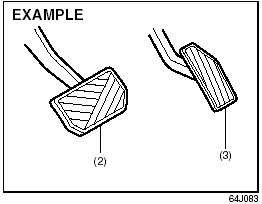
Automatic transmission
Clutch Pedal (1)
(For manual transmission). The clutch pedal is used to disengage the drive to the wheels when starting the engine, stopping or shifting the gearshift lever or transfer lever. Depressing the pedal disengages the clutch.
CAUTION: Do not drive with your foot resting on the clutch pedal. It could result in excessive clutch wear or clutch damage.
Brake Pedal (2)
Your SUZUKI vehicle is equipped with front disc brakes and rear drum brakes. Depressing the brake pedal applies both sets of brakes. You may hear occasional brake squeal when you apply the brakes. This is a normal condition caused by environmental factors such as cold, wet, snow, etc.
 WARNING: If brake squeal is excessive
and occurs each time the brakes are applied, you should have the brakes checked
by your SUZUKI dealer.
WARNING: If brake squeal is excessive
and occurs each time the brakes are applied, you should have the brakes checked
by your SUZUKI dealer.
 WARNING: Do not “ride” the brakes
by applying them continuously or resting your foot on the pedal. This will result
in overheating of the brakes which could cause unpredictable braking action, longer
stopping distances or permanent brake damage.
WARNING: Do not “ride” the brakes
by applying them continuously or resting your foot on the pedal. This will result
in overheating of the brakes which could cause unpredictable braking action, longer
stopping distances or permanent brake damage.
Accelerator Pedal (3)
This pedal controls the speed of the engine. Depressing the accelerator pedal increases power output and speed.
Gearshift Lever
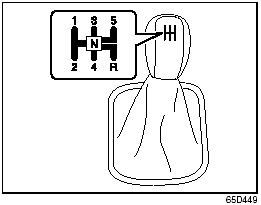
Manual transmission
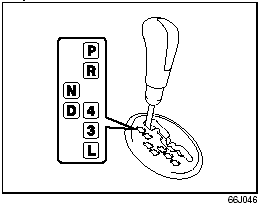
5-speed automatic
transmission
Your vehicle is equipped with either a manual transmission or automatic transmission. The gearshift lever for each transmission type is shown in the illustrations. For details on how to use the transmission, refer to the “Using the Transmission” in “OPERATING YOUR VEHICLE” section.
Fuel Filler Cap
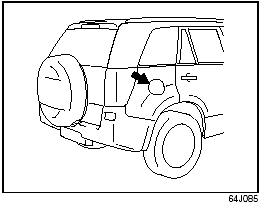
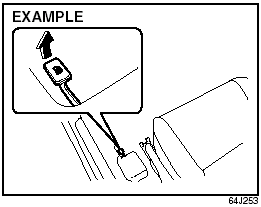
The fuel filler cap is located on the right rear side of the vehicle. The fuel filler door can be unlocked by pulling up on the opener lever located on the outboard side of the driver’s seat and can be locked by simply closing the door.
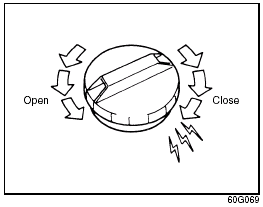
To remove the fuel filler cap: 1) Open the fuel filler door. 2) Remove the cap by turning it counterclockwise.
 WARNING: Remove the fuel filler
cap slowly. The fuel may be under pressure and may spray out, causing injury.
WARNING: Remove the fuel filler
cap slowly. The fuel may be under pressure and may spray out, causing injury.
To reinstall the fuel filler cap: 1) Turn the cap clockwise until you hear several clicks. 2) Close the fuel filler door.
 WARNING: Gasoline is extremely
flammable. Do not smoke when refueling, and make sure there are no open flames or
sparks in the area.
WARNING: Gasoline is extremely
flammable. Do not smoke when refueling, and make sure there are no open flames or
sparks in the area.
 WARNING: If you need to replace
the fuel cap, use a genuine SUZUKI cap. Use of an improper cap can result in a malfunction
of the fuel system or emission control system. It may also result in fuel leakage
in the event of an accident.
WARNING: If you need to replace
the fuel cap, use a genuine SUZUKI cap. Use of an improper cap can result in a malfunction
of the fuel system or emission control system. It may also result in fuel leakage
in the event of an accident.
See also:
Special driving conditions
Hazardous driving conditions When hazardous driving conditions are encountered
such as water, snow, ice, mud, sand, or similar hazards, follow these suggestions:
• Drive cautiously and allow extra distance for braking. • Avoid sudden movement ...
Engine Coolant
Selection of Coolant
To maintain optimum performance and durability of your engine, use SUZUKI Genuine
Coolant or equivalent. This type of coolant is best for your cooling system as it:
• Helps maintain proper engine temperature.
• Gi ...

 Anti-Theft Feature
Anti-Theft Feature